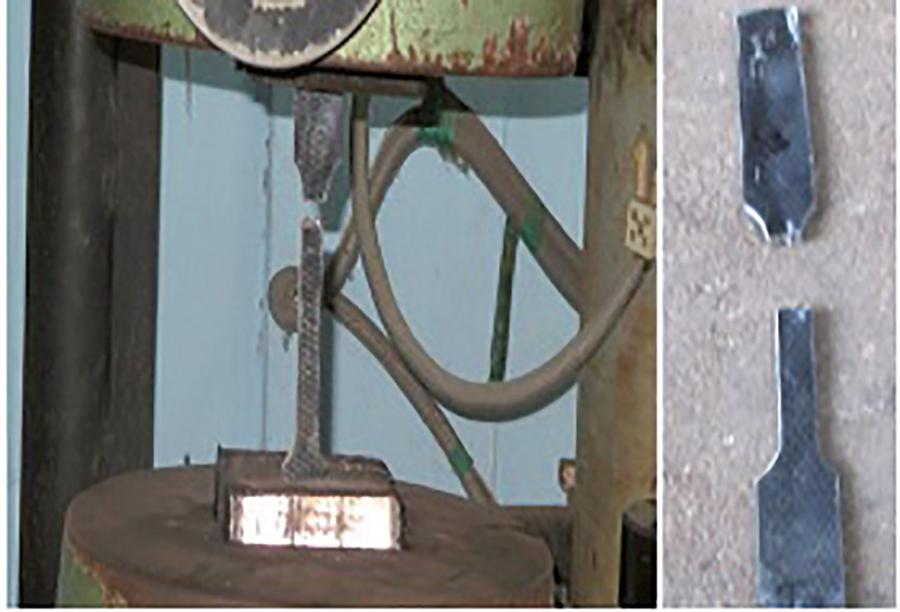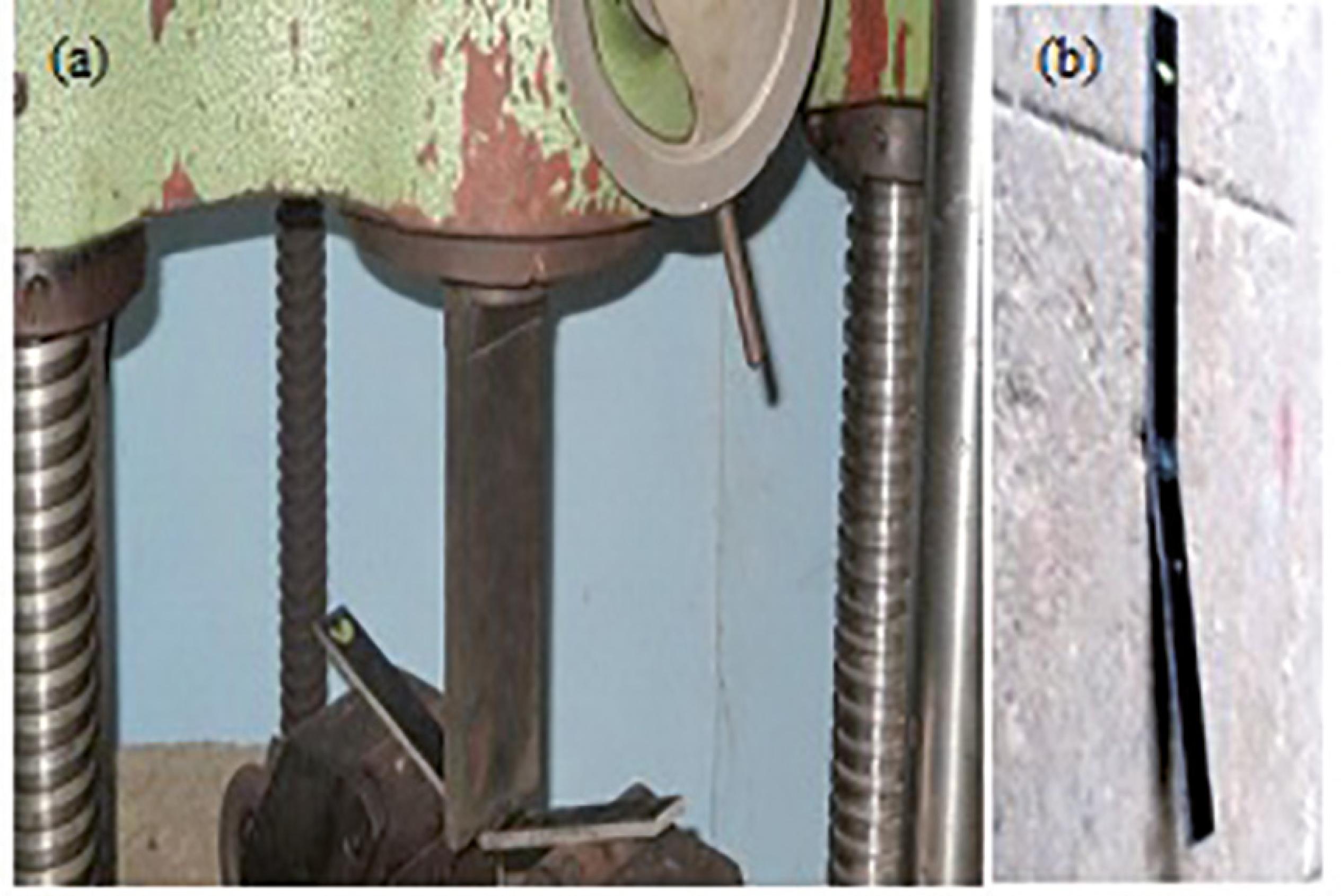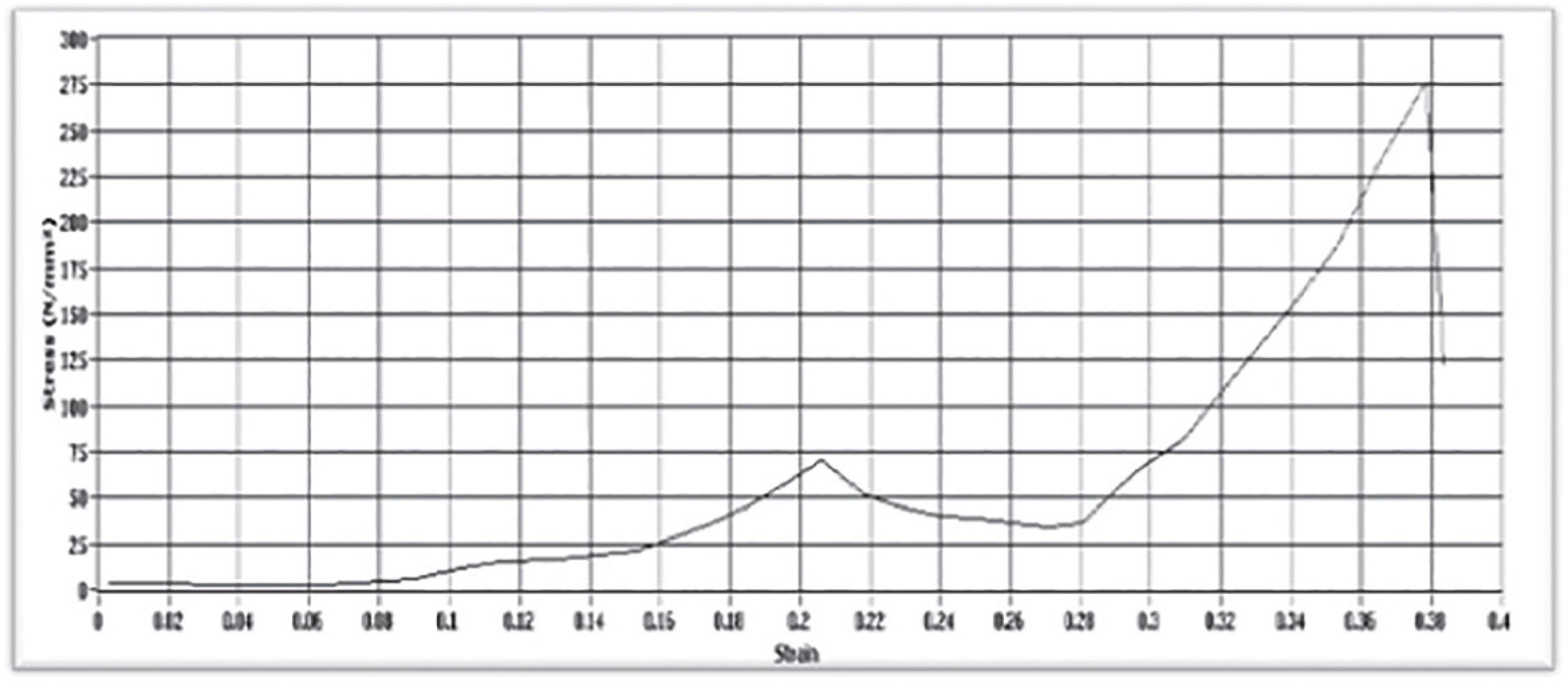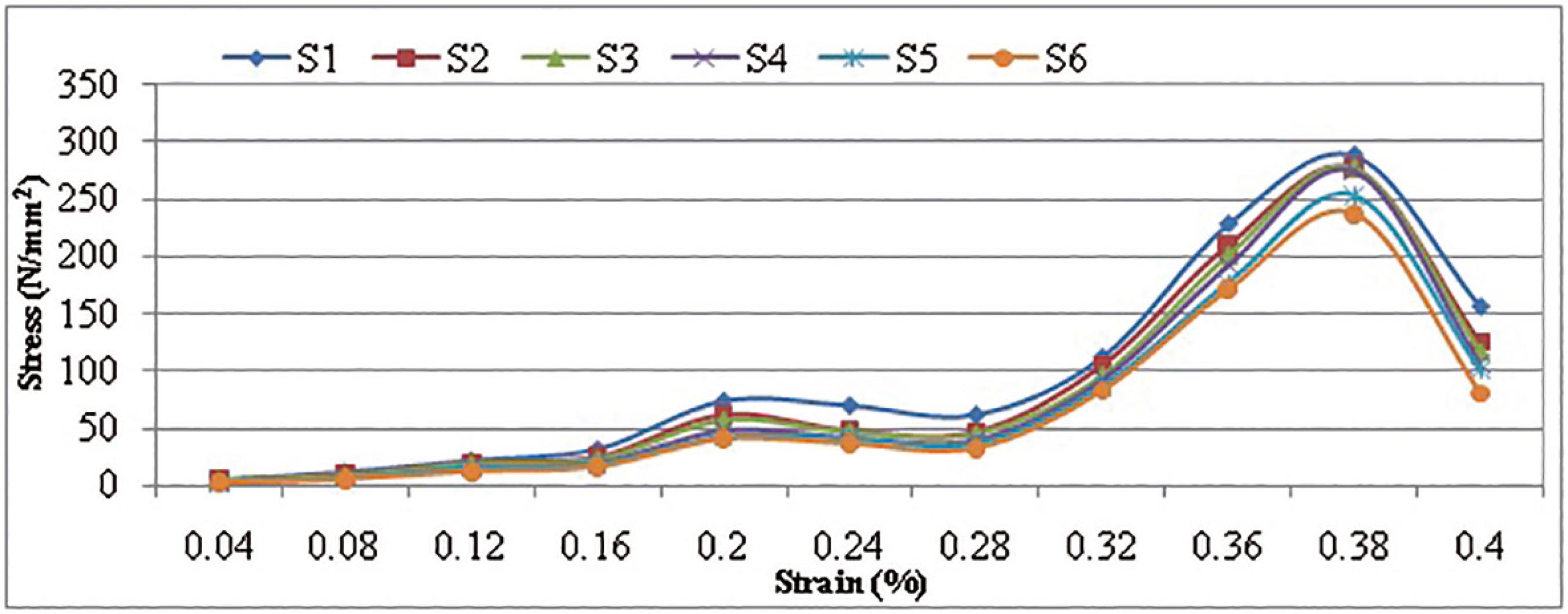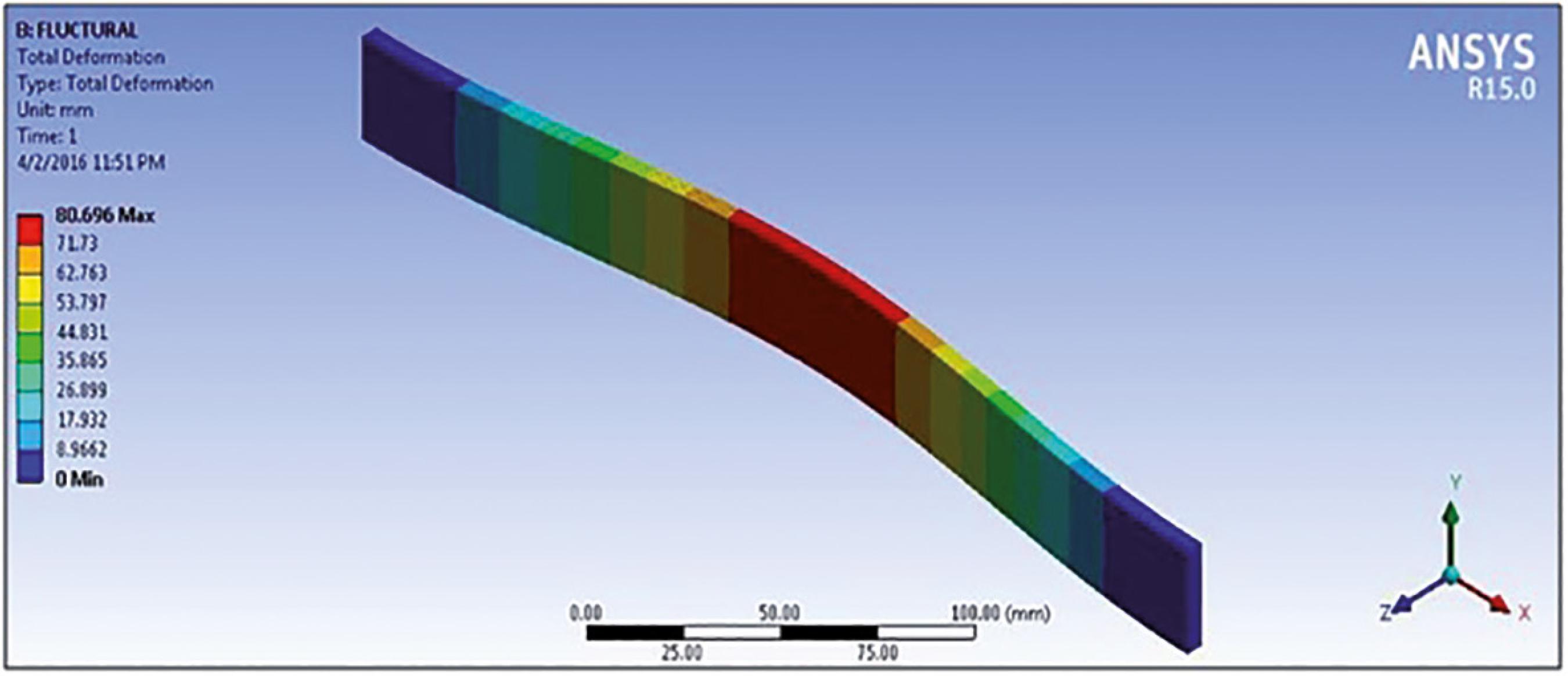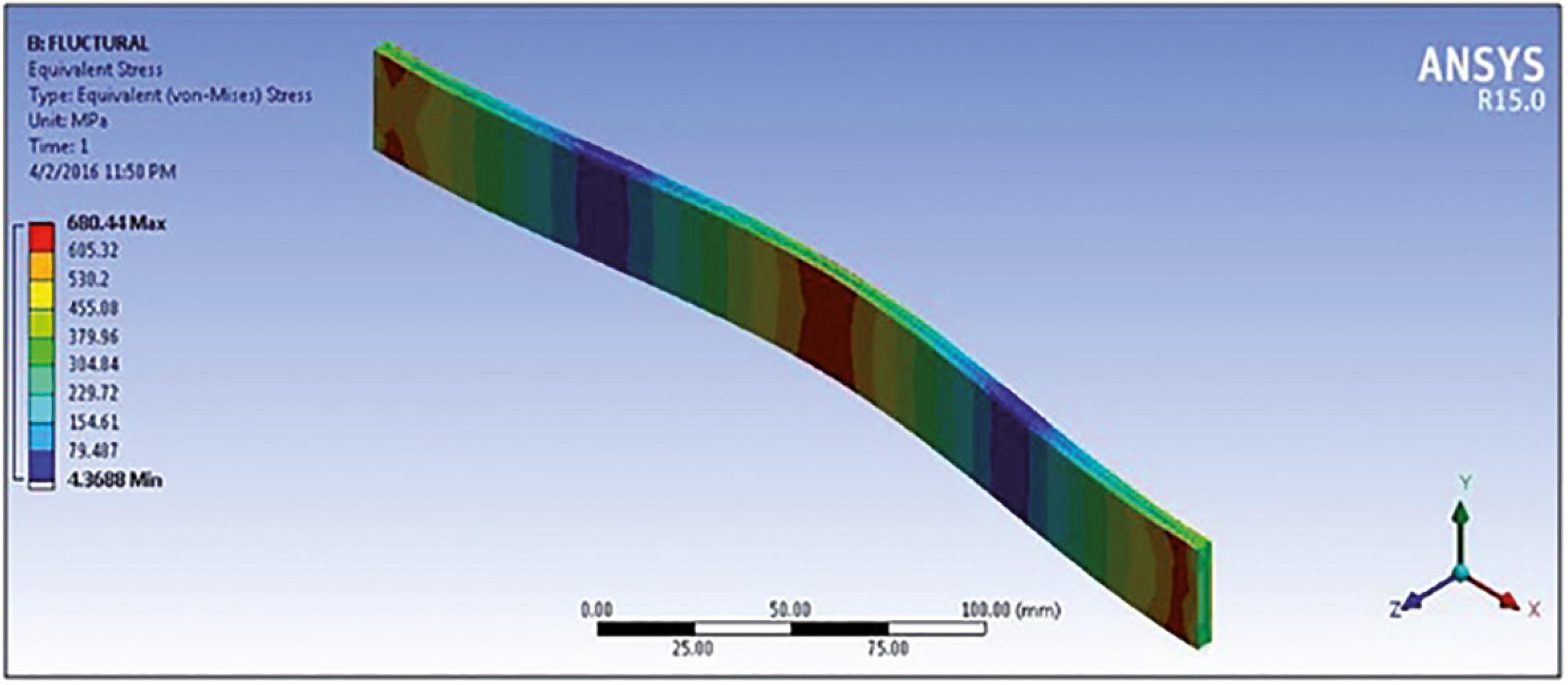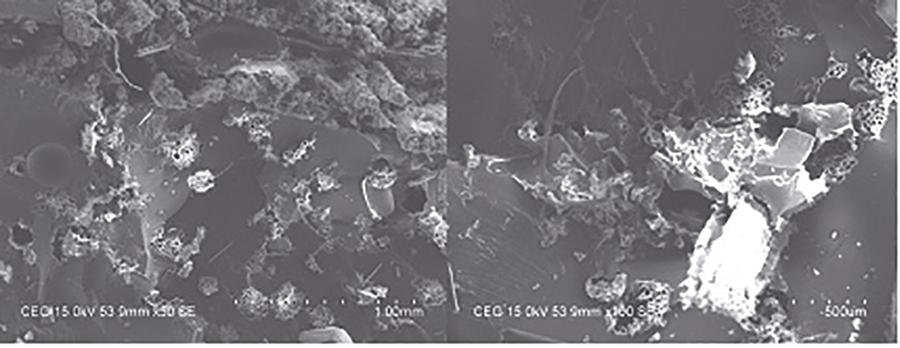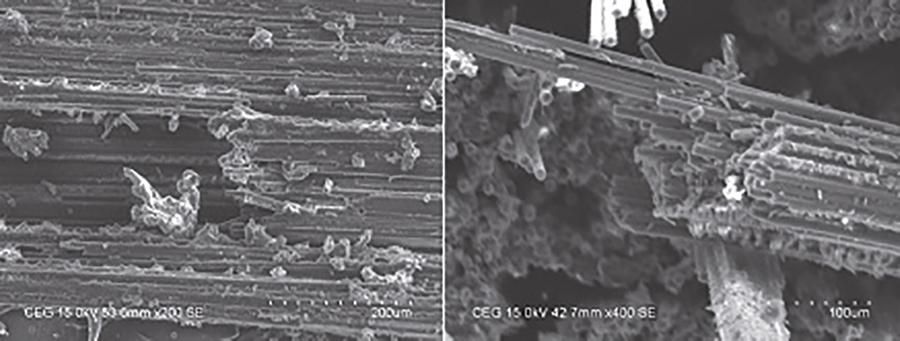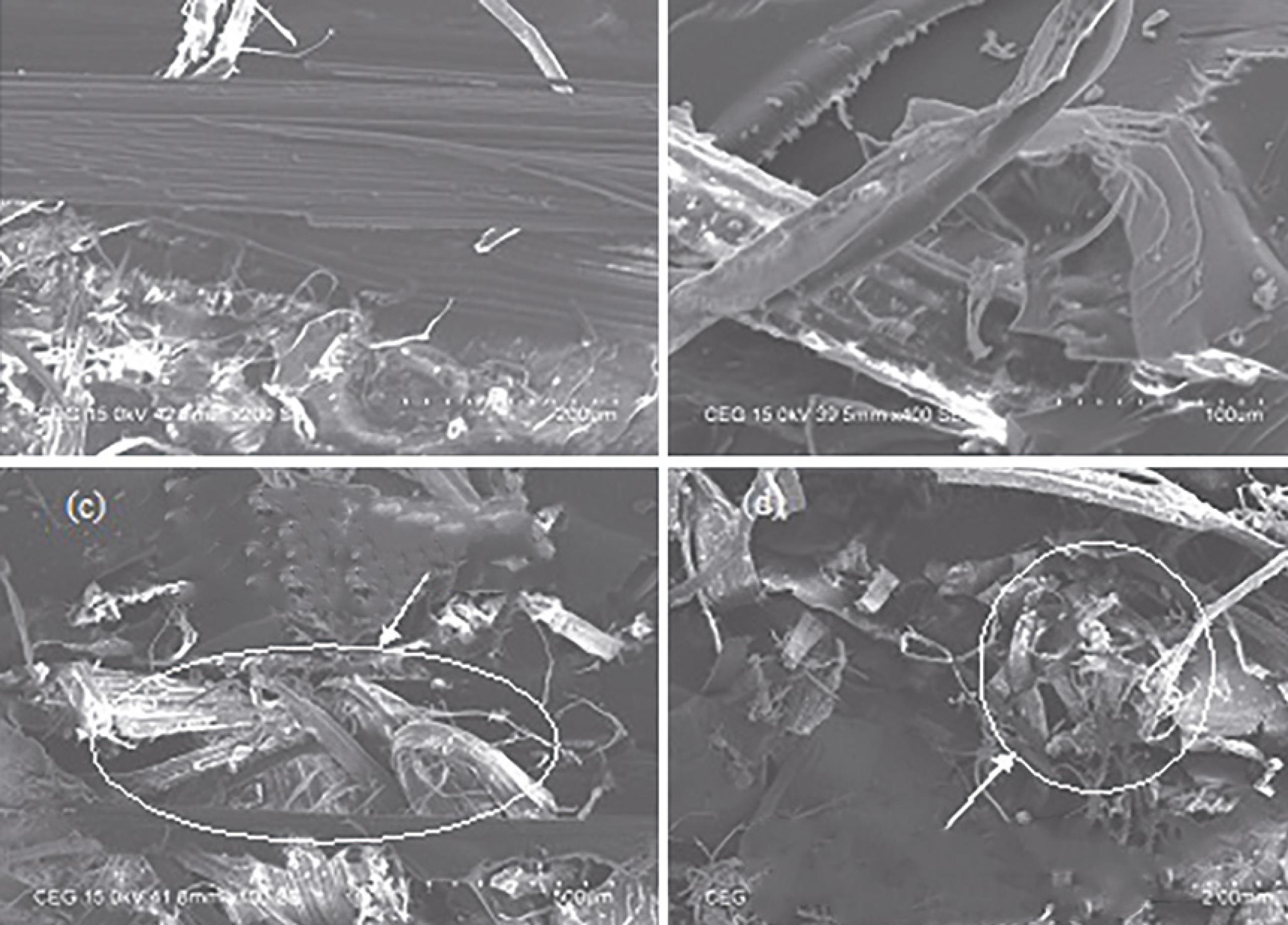The concern for the environmental pollution and the prevention of resources has attracted researchers to develop new eco-friendly green materials based on sustainability principles. In this experimental study, there are six different composite samples were fabricated by using banana and carbon fibers with epoxy resin matrix. The mechanical properties such as tensile strength, flexural strength, impact strength, and water uptake properties of these composites have been evaluated. The composites reinforced with pure carbon fibers can hold the maximum tensile strength of 288.03 MPa, flexural strength of 3.12 kN, impact strength of 4.58 J and water intake percentage of 62.3%. Whereas the composites reinforced with carbon and banana fibers can withstand the maximum tensile strength of 277.06 MPa, flexural strength of 3.07 kN, impact strength of 4.36 J and water intake percentage of 70%. The finite element analysis has been carried out to predict the mechanical properties of the composites by using ANSYS 15.0. The experimental results are compared with the predicted values and have found that, there is a high correlation occurs between the results. Scanning electron microscopy (SEM) analysis is carried out to study the fiber matrix interfaces and analyse the structure of the fractured and water absorbed surfaces.
Keywords:
Banana fiber; Carbon fiber; Hybrid composites; Mechanical properties; Scanning electron microscopy (SEM)
1. Introduction
A designer is always interested in the estimation of failure stresses of the material and wants to employ the design and the most important characteristics for almost all engineering components include mechanical properties and/or methods of fabrication of the material. Nowadays, the application of composites as structural materials is fast growing rate, it follows that the ability of the designer to design for the characteristics of composites is an important advantage1. Over the past two decades, plant fibers have been receiving considerable attention as substitutes for synthetic fiber reinforcements. Unlike the traditional synthetic fibers like glass and carbon the plant fibers are able to impart certain benefits to the composites such as low density, high stiffness, low cost, renewability, biodegradability, environmentally-friendly and high degree of flexibility during processing2-8. The properties of the natural fiber composites are strongly dependent on the fiber properties as well as on the structural parameters such as fiber diameter, length, distribution, orientation, volume fraction of the fibers and layering arrangement in composites. The mechanical properties of natural fibers are comparable to those of synthetic fibers. Thus, the natural fibers have already proved its strength and can satisfy the requirements of the global market especially for those industries more concerned in weight reduction, such as road transport, construction, packaging and aerospace applications9-14.
The thermal properties of natural fibers reinforced composites are in general much lower than that of synthetic one. Consequently, it is more difficult to dissipate the heat and in some situations, this can be an important consideration, particularly if electronic components are situated very close to the material15. Despite these advantages, natural fibers are hydrophilic have low impact strength, have non-uniformity, and have a low processing temperature and hence this limits their applications. On the other hand natural fibers could lead to a weight reduction of 10-30%16,17. However, it has some of the disadvantages like poor surface characteristics, more moisture absorption, quality variations, etc. The tensile load carrying capacity of the natural fiber reinforced composites are found to be increasing with the fiber content up to an optimum level and then start declining18.
According to new environmental regulations and societal concern, it is important to trigger the usage of degradable constituents for the production of composites at the maximum possible extent. In this regards, some of the engineering applications like sports articles, panel boards, gardening items and food packaging industries are developed from the bio-composites with minimum ecological impact and also they do not require any excellent mechanical properties19,20. However, the sacrificing strength of natural fiber composites should be considered into account before the replacement of any composite product fabricated with synthetic fiber particularly in the field of automobile and construction industries21,22. Among various natural fibers, the existence of banana fibers provide accountable contribution to thermoset polymer matrix composites for the attainment of various properties such as mechanical, thermal degradation, swelling and dielectric properties23-25.
When the banana fruit is harvested, a large amount of biomass remains because each banana plant cannot be used for the next harvest26. Hence without any additional cost banana fibers can be used for industrial purposes and will benefit the environment significantly27. Banana fibers are a waste product and without incurring much cost, the fibers can be used for industrial purposes28,29. Zaman et al30 investigated the influence of acrylic monomer and starch on the banana fiber/low density polyethylene (LDPE) composites. They prepared banana fiber reinforced LPDE composites by using the monomer treated fibers and cured under UV radiation. They found that there was a remarkable improvement on properties of the composites after monomer treatment. Aseer et al31 prepared chemically treated banana fiber composites and evaluated the physical, thermal and morphological properties. The results indicated that, the treated banana fiber composites showed good physical properties and low moisture absorption characteristics with respect to untreated one. It was further indicated that the percentage of weight loss in treated fibers is less compared with raw fiber which may be attributed to the removal of cellulose and hemicelluloses while treating. The surface treatment results indicated that treated banana fibers can be a good choice as reinforcement in the manufacture of bio-composites32.
Sathasivam et al33 prepared the banana trunk fibers and polyvinyl alcohol blended composite films and examined their physical characteristics. They found that the increase in the fiber content improved the physical characteristics and decreased the degree of swelling when compared to unblended films. They suggested that these films can be used as an alternate replacing material for food packaging materials. Biswal et al34 examined the mechanical and morphological properties of polypropylene modified banana fiber nano-composites and observed that the improved mechanical properties by treating the mercerized banana fibers with NaOH solution. Addition of 30 wt.% mercerized banana fibers to polypropylene nano-composites improves the tensile strength up to 79.9% and the flexural strength by 68.8%. Morphological observations confirmed that the removal of cementing agents from raw banana fibers enhanced the fiber adhesion properties with matrix. The electrical properties of banana and other natural fibers reinforced high density polyethylene composites have been studied and found that the untreated banana fiber showed better resistivity and volume resistivity while maleic anhydride treated agave fiber composites showed minimum surface resistivity and volume resistivity35.
The mechanical properties such as tensile strength, flexural strength, impact strength and water absorption properties of sisal and banana fibers reinforced composites have been observed and found that there is the significant improvement in mechanical strength and reduction in water absorption rate while hybridizing the banana fiber with sisal fiber reinforced composites36. The banana/glass fiber reinforced composites have good tensile property with minimum deflection when compared to the flax/glass composites37. Also the banana/flax fibers reinforced composites hold more flexural and impact strengths when compared to the flax/glass fibers reinforced polymer composites. Banana, hemp and glass fiber reinforced hybrid composites have been developed and the mechanical properties of these composites were evaluated38,39. From the results it can be observed that there is the significant improvement in mechanical properties by hybridizing the banana and hemp fibers with glass fiber.
From the available literature, it has been found that, the quantitative analysis on the mechanical and water uptake properties of these composites is still a valid problem, and hence, there is a need for carrying out such studies on composite materials. To take the advantage of banana fibers, they have been added it with the carbon fibers, so that an optimal and economical composite is obtained. Hence the objective of the present experimental study is to investigate the mechanical and water intake properties of carbon/banana fibers reinforced hybrid composites and the effect of hybridization on the properties. The experimental results are compared with results obtained from finite element analysis. From the results it has been found that these hybrid composites performing better in terms of mechanical and water intake properties. Scanning electron microscope (SEM) analysis is carried out to study the fiber matrix interfaces and analyse the structure of the fractured surfaces.
2. Experimental
2.1 Materials
The materials used in this experiment for fabrication of composite specimen are banana fibers, epoxy resin, carbon fibers. The banana fibers are supplied in the form of residues by M/s. Chandra Prakash & Company, Jaipur, Rajasthan, India. The epoxy resin (Grade: LY 556), Hardener (Type: HY 951) and carbon fibers of uni-directional mat with 270gsm are purchased from M/s. S.M. Traders, Chennai, Tamil Nadu, India. The physical properties of the banana and carbon fibers are presented in Table 1 40.
2.2 Preparation of mould
The mould used for fabrication of composite is made from rectangular plywood 600 mm in length and 500 mm in width, and it is coated with plastic by using glue. The bottom and top of the mould is covered with plywood to avoid the debris from entering into the composites processing during curing. The mould used for fabrication of the composite is presented in Figure 1.
2.3 Preparation of composites
The composite samples used for the present investigation is fabricated by hand lay-up process. Banana and carbon fibers of 300 mm length were used to fabricate the specimen. The composite specimen consisting of five layers in which carbon and banana fiber layers are arranged in the alternative layers of the specimen. The layers of fibers are fabricated by adding the required amount of epoxy resin. Initially the carbon and banana fibers were dried in sun light to remove the moisture. The carbon fiber is mounted on the rubber sheet with mylar film of thickness 100 microns. The carbon fiber is then completely filled with epoxy resin. The resin got mixed with carbon fiber, which may tend to dry up within 15-20 min. Before the resin gets dried, the second layer of fiber is mounted over the first layer. The process is repeated for all five layers. The epoxy resin applied is distributed to the entire surface by means of a roller. The air gaps formed between the layers during the processing are squeezed out. The processed composite is pressed hard and the excess resin is removed and dried. Then the laminate was cured under the loaded condition for 24 hours with the help of the weight press. The size of the fabricated laminate is restricted to 300×300×5 mm. The fibers used in for fabrication of composite laminates and fabricated laminate are presented in Figure 2.
3. Mechanical properties of composites
3.1 Tensile test
The tensile test specimens are prepared as per the ASTM D638 standards and procedures. There are three samples are used from each laminate for testing tensile behavior of composites. The tensile test is performed on the universal testing machine (UTM) (Model: UTN 40, S. No. 11/98-2450; Make: FIE) and the results are observed. These methodologies are followed for remaining specimen in the same composite laminate and other composite specimens to get the average tensile strength and corresponding stresses for the comparison of results. The tensile test set-up, specimen after fracture is presented in Figure 3.
3.2 Flexural test
The flexural test specimens are prepared as per the ASTM D790 standards. The 3-point flexural test is the most common flexural test and used in this experiment for checking the bending strength of the composite samples. The three test specimens of each laminates of banana/carbon fiber reinforced epoxy composites are prepared and tested by applying the three point flexural loading with the help of same UTM. The testing process involves placing the test specimen in the UTM and applying force to it until it fractures and breaks. The result of flexural strength of each specimen is observed and the results are compared. The flexural test set up and specimen after fracture of banana/carbon fibers reinforced epoxy composites are presented in Figure 4.
3.3 Impact test
The impact test specimens are prepared according to the required dimension as per the ASTM A370 standards. The testing process involves placing the test specimen in the UTM (Model: KL-300, S. No. 96/1054, Make: Krystal Elmec). During the testing process, the specimen must be loaded in the testing machine and allows the pendulum to break the specimen. Using the impact test, the maximum energy needed to break the material can be measured easily. The V-notched impact test specimen after fracture of banana/carbon fibers reinforced epoxy composites are presented in Figure 5.
3.4 Water intake test
The water intake test specimens are prepared as per the ASTM D570 standards. For the water absorption test, the specimens are dried in an oven for a specified time and temperature and then placed in a desiccator to cool. Immediately upon cooling the specimens are weighed. The material is then emerged in water at agreed upon conditions, often 23°C for 24 h or until equilibrium. Specimens are removed, patted dry with a lint free cloth, and weighed. It is measured using meter balance. The Figure 6 shows the soaked specimen and measuring of its weight. The percentage of water absorbed by the composite material was calculated by using weight difference between the samples immersed in water and the dry samples using Eq. (1)
where ΔM(t) is water uptake at time t, mt and m0 are the the wet weight and dry weight of the specimen at time t, respectively. The movement of the solvent molecules in the polymer segments is characterized by the diffusion coefficient.
3.5 Finite element analysis (FEA)
To predict some of the resulting important mechanical properties, a finite element analysis has been carried out. The elastic-plastic transition behavior in composites is not easy to study under experimental conditions; therefore theoretical modeling is needed to validate the results. In addition to validate the experimental findings, the theoretical prediction of these properties has shortened the cycle time, which maximizes the resulting composite properties41. The ANSYS 15.0 is the premier finite element structural analysis solver for linear and nonlinear analysis and optimization. The vonmises stress is included in the output for those elements, that supports stress calculation when computing the response of a structure due to random loads. Preliminary results from tensile, flexural, and impact tests have indicated that, the composite material is very brittle but has exhibited the linear deformation in its elastic state. The composite plate is constrained (all 6 DOF arrested) at a point where the two symmetrical axes are intersecting each other. The loads were applied on both sides along the length of the components. Failure modes of the composites include elastic deformation, plastic deformation, strain hardening, necking and fracture. But unfortunately we cannot capture these processes in numerical simulations, because software follows a different stress-strain curve which is not the actual one. The results from tensile, flexural, impact tests indicated that the composite material was very brittle but exhibited linear deformation in its elastic state.
3.6. Morphological studies
The instrument, (Model: JEOL JSM-6480LV) is used to analyze the morphological properties of banana/carbon fiber reinforced hybrid composites. In most applications, data are collected over a selected area of the surface of the sample, and a two dimensional image is generated that displays spatial variations in these properties. The morphological study is also capable of performing to analyze selected locations on the sample; this approach is especially useful in qualitatively or semi-quantitatively determining the chemical composition, crystalline structure, and crystal orientations. To prepare specimens for the SEM, they are first fixed with fixative, and then taken through a graded alcohol dehydration series. Once dehydrated, the specimens are placed in a critical point dryer, and then in a gold coater. After the gold coating is complete, the specimens are ready to be viewed on the SEM. Images may be scanned on a digital imaging system by computer enhancement, or polaroid pictures may be taken using an attached camera. The samples are prepared at different thicknesses of 0.1cm, 0.3cm, and 0.5cm and the morphology surfaces were observed at an accelerating voltage of 2 kV in room temperature. The results are in the form of black and white images with our interpretation of their meaning.
4. Results and discussion
As a consequence, there is a growing interest in producing green, eco-friendly materials. As far as composites are concerned, one solution could be to use natural fibers instead of more traditional glass and carbon fibers. The samples are tested in their corresponding testing machines and the tensile, flexural and impact properties are determined. Each type of sample is tested three times and the average values are used for analysis. The experimental results of the banana/carbon fiber composites are presented in Table 2.
4.1 Experimental analysis
4.1.1 Tensile strength analysis
The banana/carbon fibers reinforced composite specimen are prepared with different volume fractions and tested in the UTM. The typical stress versus strain curve generated directly from the machine during tensile loading is presented in Figure 7. From the figure it can be observed that, the stress is gradually increasing and then decreasing suddenly. This indicates that the stress increases up to the maximum load carrying capacity of the material and sudden deceasing after the material has been broken. The figure further revealed that the maximum stress in the material is 275 N/mm2 at the strain rate of 0.38. The stress-strain curve for all the composite samples tested is presented in Figure 8. From the figure, it can be asserted that the maximum stress obtained for all the composite samples are at the strain rate of 0.38. The tensile strength comparisons of carbon/banana fiber reinforced hybrid composites is presented in Figure 9. From the figure it has been clearly observed that the pure carbon fiber reinforced epoxy composites are performing better than the other composite combinations tested. This is higher than that of the average tensile strength for banana/glass fibers reinforced hybrid composites38,39.
4.1.2 Flexural strength analysis
The stress vs. strain curves of the composite samples subjected to flexural loading is presented in Figure 10. From the figure it has been observed that, the stress increases with the increase of strain up to around 700 N/mm2, then it tends to decrease, i.e., after material fracture takes place. From the graph, it has been noticed that pure carbon fiber composites is performing well when compared to other types composites tested followed by 80% carbon and 20% banana fiber reinforced composites. The flexural strength comparisons of the different combinations of the carbon/banana fiber reinforced composites are presented in Figure 11. The results indicated that the pure carbon fiber reinforced composites are performing better than the banana/carbon fiber composite combinations were tested. This is due to the poor flexural strength of the natural fibers when compared to the synthetic carbon fibers. The results have proved that the flexural strength of the natural fiber composites is lesser than that of the synthetic one. The flexural strength values of these composites are well ahead with the already published results38,39.
4.1.3 Impact strength analysis
For evaluating and analyzing the sudden load carrying or energy absorbing capacity of the banana/carbon fiber reinforced composite samples an impact test is carried out. The energy loss is found out on the results obtained from the charpy impact testing machine. The impact strength comparisons of different hybrid composites are presented in Figure 12. From the figure it is observed that the impact strength of the composites varies from 3 to 5 Joules. As like the tensile and flexural strength, the impact strength of the pure carbon fiber composites is greater that of the pure banana fiber reinforced composites. The banana/carbon fibers reinforced hybrid composites performing intermediate between these two. These results are little bit lower when compared to the similar test results carried out other researcher but comparable38,39. This is due to variation in weight of the pendulum, impact velocity, etc.
4.2 Analysis by using FEA
4.2.1 Analysis of tensile strength
The typical FEA simulation plots for the tensile test specimen are presented in Figure 13. The FEA simulation has been carried out only for the hybrid composite samples (S2 and S3). The simulated stress distribution for tensile properties of banana/carbon fiber hybrid composites was obtained under different loading conditions. From the plots it is observed that the specimen can withstand the maximum tensile strength of 269.27 (S2) and 270.73 (S3) MPa. This is located approximately at the middle portion of the specimen where the maximum stress occurs which is observed from figures. Results from tensile test indicated that the composites are very brittle but exhibited linear deformation in its elastic state. It is found that the results from FEA analysis are very closer to the experimental results.
4.2.2 Analysis of flexural strength
Figure 14 shows the typical FEA simulation result plot of the sample deformation when it is subjected to flexural loading. The analysis yields a maximum deflection of 80.69 mm at the region of load application and 0 mm deflection where load does not act. The stress distribution at the various places on the specimen is shown in Figure 15 which gives the value of maximum stress under flexural loading as 680.44 MPa. From the figure it is observed that the maximum stress is acting in the middle of the specimen as well as the ends. The result from flexural test further indicated that the failure of the composites takes place immediately after its elastic state which gives very less linear deformation. It is observed that there is close correlation occur between the experimental results and results obtained from FEA.
4.2.3. Analysis of impact strength
Figure 16 depicts the typical ANSYS model and maximum strain energy plot for impact loading. The figure shows that maximum impact energy is produced in the region where the hammer strikes in charpy test and the strain energy was found to be 3.9174 Joules. The simulated stain energy distribution for impact properties of the hybrid composites was obtained under different loading conditions. Results from impact test indicated that the nature of the composites is brittle when the sudden load is applied. It is also found that the FEA analysis results are very closer to the experimental results.
4.3 Water intake analysis
The absorption of water by the natural fiber is related to the permeability of the water molecules through the bio-composite material. The comparisons of the percentage water intake of different hybrid composites are presented in Figure 17. The water intake behavior of the banana/carbon fiber reinforced composites is in the order of reverse when compared to its mechanical properties. This means the water intake behavior of pure banana fiber composites are superior than the pure synthetic fiber composites. From the results it has been confirmed that the major drawback of any natural fiber and its composites is the moisture absorption nature. This has been proved by various experimental studies done by different researchers. The water intake behavior results obtained in this experimental study are well correlated with the results obtained by Ramesh et al.42.
4.4 Scanning electron microscopy (SEM) analysis
The structure of the fractured surfaces of the fractured and water absorbed specimens are observed through SEM analysis. The SEM micrographs are used to observe the internal cracks, fractured surfaces and internal structure of the tested samples of the banana/carbon fiber reinforced composites. The SEM micrographs of the sample subjected to tensile loading are presented in Figure 18. The reinforcement of the banana fibers and fiber fracture due to tensile loading are clearly visible from the micrographs. The images have the similar fashion with already published results38,39.
The SEM images of the composite samples subjected to flexural loading are given in Figure 19. The figure clearly showed that the broken banana fibers due to the application of load acting to the perpendicular direction of the fiber reinforcement. The figure further revealed that the arrangement of the banana and carbon fibers and fiber dispersion in to the matrix. The SEM micrographs of the samples subjected to impact loading are presented in Figure 20. The breakage of the banana fiber layer is clearly visible in the images due to the sudden loading. The images have high correlation with the images of the samples subjected to similar loading which is available in the published results38,39.
The SEM micrographs of the samples subjected to water intake test are presented in Figure 21. From the images it can be observed that, the water absorbed matrix layer, fiber swelling due to moisture, etc. The images have the similar fashion with already published results42.
5. Conclusion
The banana and carbon fibers reinforced hybrid composites were fabricated by hand lay-up process and the mechanical properties such as tensile strength, flexural strength, impact strength and water intake behaviour of these composites have been evaluated. The FEA analysis has been done to validate the results by using the simulation software ANSYS 15.0. The SEM analysis is carried out to observe the interfacial characteristics and internal surface of the fractured specimen. The following conclusions have been derived from the experimental investigations and FEA analysis.
-
The hybrid composites which contains 20% carbon fiber and 80% banana fiber (Sample S2) have more tensile strength than other composites can withstand the tensile strength of 277.06 MPa followed by sample S3 which holds 276.04 MPa.
-
The maximum flexural strength of 3.12 kN holds by the pure carbon fiber composites and in the case of hybrid composites, the sample S2 (20% carbon fiber and 80% banana fiber) holds the value of 3.07 kN.
-
The maximum impact strength of the banana-carbon fiber hybrid composites are 4.36 Joules. This is just behind the pure carbon fibre composites which holds the value of 4.58 Joules.
-
The percentage of water intake characteristics varies from 62.3 to 98%. When compared to the carbon fiber, banana fibers were absorb more water.
-
The values obtained in ANSYS modeling were 270.73 MPa for tensile test, 680.4 MPa for flexural test and 3.91 Joules in impact strength test.
-
It has found out that, the discussed FEA model results are very close to the experimental values and hence it is used for predicting properties required for different applications.
-
From the morphological observations the interfacial characteristics, internal structures of the fractured surfaces, fiber failure mode, fiber pull out and fiber dislocation are clearly observed.
6. References
- 1 Ihueze CC, Okafor CE, Okoye CI. Natural fiber composite design and characterization for limit stress prediction in multi-axial stress state. Journal of King Saud University -Engineering Sciences 2015;27(2):193-206.
- 2 Rao KMM, Rao KM, Prasad AVR. Fabrication and testing of natural fiber composites: Vakka, sisal, bamboo and banana. Materials & Design 2010;31(1):508-513.
- 3 Jagadeesh D, Prem Kumar B, Sudhakara P, Venkata Prasad C, Varada Rajulu A, Song JI. Preparation and Properties of Propylene Glycol Plasticized Wheat Protein Isolate Novel Green Films. Journal of Polymers and the Environment 2013;21(4):930-936.
- 4 AL-Oqla FM, Sapuan SM. Natural fiber reinforced polymer composites in industrial applications: feasibility of date palm fibers for sustainable automotive industry. Journal of Cleaner Production 2014;66:347-354.
- 5 Le Moigne L, Longerey M, Taulemesse JM, Bénézet JC, Bergeret A. Study of the interface in natural fibers reinforced poly(lactic acid) biocomposites modified by optimized organosilane treatments. Industrial Crops and Products 2014;52:481-494.
- 6 Bismarck A, Mishra S, Lampke T. Plant Fibers as Reinforcement for Green Composites. In: Mohanty AK, Misra M, Drzal LT, eds. Natural Fibers, Biopolymers, and Biocomposites Boca Raton: CRC Press; 2005.
- 7 Luckachan GE, Pillai CKS. Biodegradable Polymers- A Review on Recent Trends and Emerging Perspectives. Journal of Polymers and the Environment 2011;19(3):637-676.
- 8 Satyanarayana KG, Guimarães JL, Wypych F. Studies on lignocellulosic fibers of Brazil. Part I: Source, production morphology, properties and applications. Composites Part A: Applied Science and Manufacturing 2007;38(7):1694-1709.
- 9 Liu W, Drzal LT, Mohanty AK, Misra M. Influence of processing methods and fiber length on physical properties of kenaf fiber reinforced soy based biocomposites. Composites Part B: Engineering 2007;38(3):352-359.
- 10 Pietak A, Korte S, Tan E, Downard A, Staiger MP. Atomic force microscopy characterization of the surface wettability of natural fibres. Applied Surface Science 2007;253(7):3627-3635.
- 11 Edeerozey AMM, Akil HM, Azhar AB, Ariffin MIZ. Chemical modification of kenaf fibers. Materials Letters 2007;61(10):2023-2025.
- 12 Mohanty AK, Misra M, Hinrichsen G. Biofibres, biodegradable polymers and biocomposites: An overview. Macromolecular Materials and Engineering 2000;276-277(1):1-24.
- 13 Puglia D, Biagiotti J, Kenny JM. A review on natural fiber-based composites - part II. Journal of Natural Fibers 2005;1(3):23-65.
- 14 Dicker MPM, Duckworth PF, Baker AB, Francois G, Hazzard MK, Weaver PM. Green composites: A review of material attributes and complementary applications. Composites Part A: Applied Science and Manufacturing 2014;56:280-289.
- 15 Paul SA, Boudenne A, Ibos L, Candau Y, Joseph K, Thomas S. Effect of fiber loading and chemical treatments on thermophysical properties of banana fiber/polypropylene commingled composite materials. Composites Part A: Applied Science and Manufacturing 2008;39(9):1582-1588.
- 16 Mair RI. Tomorrow's plastic cars. In: Focus 113 Melbourne: Australian Academy of Technology and Engineering; 2000. 5 p.
- 17 Paul V, Kanny K, Redhi GG. Mechanical, thermal and morphological properties of a bio-based composite derived from banana plant source. Composites Part A: Applied Science and Manufacturing 2015;68:90-100.
- 18 Ku H, Wang H, Pattarachaiyakoop N, Trada M. A review on the tensile properties of natural fiber reinforced polymer composites. Composites Part B: Engineering 2011;42(4):856-873.
- 19 Netravali AN, Chabba S. Composites get greener. Materials Today 2003;6(4):22-29.
- 20 Rozman HD, Lai CY, Ismail H, Ishak ZAM. The effect of coupling agents on the mechanical and physical properties of oil palm empty fruit bunch polypropylene composites. Polymer International 2000;49(11):1273-1278.
- 21 Dittenber DB, GangaRao HVS. Critical review of recent publications on use of natural composites in infrastructure. Composites Part A: Applied Science and Manufacturing 2012;43(8):1419-1429.
- 22 Koronis G, Silva A, Fontul M. Green composites: A review of adequate materials for automotive applications. Composites Part B: Engineering 2013;44(1):120-127.
- 23 Prasad AVR, Rao KM, Nagasrinivasulu G. Mechanical properties of banana empty fruit bunch fiber reinforced polyester composites. Indian Journal of Fiber & Textile Research 2009;34(2):162-167.
- 24 Bilba K, Arsene MA, Ouensanga A. Study of banana and coconut fibers: Botanical composition, thermal degradation and textural observations. Bioresource Technology 2007;98(1):58-68.
- 25 El-Meligy MG, Mohamed SH, Mahani RM. Study mechanical, swelling and dielectric properties of prehydrolysed banana fiber - Waste polyurethane foam composites. Carbohydrate Polymers 2010;80(2):366-372.
- 26 Li K, Fu S, Zhan H, Zhan Y, Lucia LA. Analysis of the chemical composition and morphological structure of a banana pseudo-stem. BioResources 2010;5(2):576-585.
- 27 Joseph S, Sreekala MS, Oommen Z, Koshy P, Thomas S. A comparison of the mechanical properties of phenol formaldehyde composites reinforced with banana fibres and glass fibres. Composites Science and Technology 2002;62(14):1857-1868.
- 28 Bledzki AK, Mamun AA, Faruk O. Abaca fibre reinforced PP composites and comparison with jute and flax fiber PP composites. Express Polymer Letters 2007;1(11):755-762.
- 29 Kumar A, Singh BP, Jain RK, Sharma AK. Banana Fibre (Musa sapientum): A Suitable Raw Material for Handmade Paper Industry Via Enzymatic Refining. International Journal of Engineering Research & Technology 2013;2(10):1338-1350.
- 30 Zaman HU, Khan MA, Khan RA. Physico-Mechanical and Degradation Properties of Banana Fiber/LDPE Composites: Effect of Acrylic Monomer and Starch. Composite Interfaces 2011;18(8):685-700.
- 31 Aseer JR, Sankaranarayanasamy K, Jayabalan P, Natarajan R, Dasan KP. Morphological, Physical, and Thermal Properties of Chemically Treated Banana Fiber. Journal of Natural Fibers 2013;10(4):365-380.
- 32 Ramesh M, Atreya TSA, Aswin US, Eashwar H, Deepa C. Processing and Mechanical Property Evaluation of Banana Fiber Reinforced Polymer Composites. Procedia Engineering 2014;97:563-572.
- 33 Sathasivam K, Haris MRHM, Noorsal K. The Preparation and Characterization of Esterified Banana Trunk Fibers/Poly(vinyl alcohol) Blend Film. Polymer-Plastics Technology and Engineering 2010;49(13):1378-1384.
- 34 Biswal M, Mohanty S, Nayak SK. Effect of Mercerized Banana Fiber on the Mechanical and Morphological Characteristics of Organically Modified Fiber-Reinforced Polypropylene Nanocomposites. Polymer-Plastics Technology and Engineering 2011;50(14):1458-1469.
- 35 Naik JB, Mishra S. Studies on Electrical Properties of Natural Fiber: HDPE Composites. Polymer-Plastics Technology and Engineering 2005;44(4):687-693.
- 36 Venkateshwaran N, ElayaPerumal A, Alavudeen A, Thiruchitrambalam M. Mechanical and water absorption behaviour of banana/sisal reinforced hybrid composites. Materials & Design 2011;32(7):4017-4021.
- 37 Srinivasan VS, Boopathy SR, Sangeetha D, Ramnath BV. Evaluation of mechanical and thermal properties of banana-flax based natural fiber composite. Materials & Design 2014;60:620-627.
- 38 Bhoopathi R, Ramesh M, Deepa C. Fabrication and Property Evaluation of Banana-Hemp-Glass Fiber Reinforced Composites. Procedia Engineering 2014;97:2032-2041.
- 39 Bhoopathi R, Deepa C, Sasikala G, Ramesh M. Experimental Investigation on Mechanical Properties of Hemp-Banana-Glass Fiber Reinforced Composites. Applied Mechanics and Materials 2015;766-767:167-172.
- 40 Ramesh M. Kenaf (Hibiscus cannabinus L.) fibre based bio-materials: A review on processing and properties. Progress in Material Sciences 2016;78-79:1-92.
- 41 Ramesh M, Nijanthan S. Mechanical property analysis of kenaf-glass fibre reinforced polymer composites using finite element analysis. Bulletin of Materials Science 2016;39(1):147-157.
-
42 Ramesh M, Palanikumar K, Reddy KH. Influence of fiber orientation and fiber content on properties of sisal-jute-glass fiber reinforced polyester composites. Journal of Applied Polymer Science 2016;133(6). DOI: 10.1002/app.42968
» https://doi.org/10.1002/app.42968

 Mechanical and Water Intake Properties of Banana-Carbon Hybrid Fiber Reinforced Polymer Composites
Mechanical and Water Intake Properties of Banana-Carbon Hybrid Fiber Reinforced Polymer Composites


